Uncovering the stories of giant trees of the past is an exercise in grief.
What more is there to say?
The following are stories and pictures of some of the ancient giants of our eastern forests. Curiously, records of trees which were found a hundred years ago greatly exceed the biggest, tallest trees of their kind found today, as graphed by Henry & Quinby in “Ontario’s Old-growth Forests.”

From ” Ontario’s Old-growth Forests ” by Henry & Quinby
From ” Ontario’s Old-growth Forests ” by Henry & Quinby
Is this because the logging practices of high-grading removed the genes for largest size? Or have ecological or climatic changes stunted the growth of today’s trees? Perhaps modern fire suppression results in forests that are overcrowded and hence stunted. Or maybe it is the workings of time, where our 200-year-old forest growth seems immature beside five and six hundred years old sentinels. Whatever the causes, here are the accounts…
Big Trees in History
In 1853, Samuel Strickland measured a white oak (Quercus alba) in Ontario, Canada that was 11 feet wide, 6 feet off the ground. It was allegedly 60-80 feet to the nearest branch. Known as the Beverly-oak, the great stood uncut by a tavern for years only because there wasn’t a saw long enough to fell him. Strickland mentions a giant black cherry, too.
The land is well timbered with the best description of hard wood, amongst which is to be found in considerable abundance, the black cherry. This tree grows often to a large size, and is used extensively for furniture, particularly for dining-tables: if well made and polished, it is little inferior to mahogany, either in appearance or durability.
I remember, on this very journey, that Mr. Prior and myself were much struck by the size and magnificent appearance of one of these cherry-trees, which grew close to the road side, not far from the Big Thames. Two years afterwards, passing the same tree, I got out of my sleigh and measured the circumference as high as I could reach, which I found to be ten feet seven inches, and, I should think, it was not less than fifty feet in height from the ground to the first branch: it is a great pity to see such noble trees as these either burned or split up into fencing-rails.
I think the largest tree of the hard wood species I ever saw in this country, was near Bliss’s Tavern, in the township of Beverly, and it was called the Beverly-oak. I was induced to visit this giant of the woods from the many accounts I had heard of its vast dimensions, and was, certainly, astonished at its size and symmetry. I measured it as accurately as I could about six feet from the ground, and found the diameter to be as nearly eleven feet as possible, the trunk rising like a majestic column towering upwards for sixty or seventy feet before branching off its mighty head. Mr. Galt, who was induced to visit this tree from my description has, in his “Autobiography,” mentioned the height of the trunk from the ground to the branches, as eighty feet; but I think he has overrated it. I was accompanied to the tree by the landlord, who remarked, “that he calculated that he should cut that ‘ere tree down some day, for he guessed it would make enough rails to fence the side of a ten acre field.”
I replied, “Surely, you would not be such a Goth as to cut down such a splendid oak merely for fence-wood, when you have plenty of rail-timber which will answer that purpose equally well; and, besides, it may be the means of drawing customers to your tavern.”
“I do not know what you mean by a Goth; but I do know, if I could get a cross-cut saw long enough to cut that tree, I would not let it stand there long; for you see it is mighty straight in the grain, and would split like a ribbon.”
Thus was this gigantic specimen of the primeval forest preserved for a time, because there was not a saw long enough to cut it through in Canada. I dare say there are many old oaks in England that exceed this in diameter; but I do not believe one is to be found whose length of trunk can be at all compared to it.
Samuel Strickland, Twenty Seven Years in Canada West, 1853.
Compared to the largest white oak’s of today, the proportions of the Beverly-oak seem unbelievable. But oaks of similar dimension were described in West Virginia.
In 1913, a white oak was felled near Lead Mine, in Tucker county West Virginia which was supposedly 13 feet in diameter 16 feet from the base, and 10 feet in diameter 31 feet from the base. The trunk was so large that dynamite was needed to split the tree into quarters to be skidded to the railroad. (“Transforming the Appalachian Countryside“, see also “Tumult on the Mountains: Lumbering in West Virginia 1770-1920,” Roy B. Clarkson 1964)
Another massive white oak was documented with photos. This tree was on Trace Fork in Mingo county, West Virginia. The famous Mingo Oak was 145 feet tall, had a spread of 96 feet, a diameter of 8 feet 7 inches at breast height (26.965 feet circumference!), and was 66 feet from the ground before the first limb. It was cut down in 1938 after dying the previous year, and was found to be 582 years old. Discs cut more than 90 feet off the ground, where the diameter exceeded three-and-a-half feet, are on display at the state museum in Charleston and in Percival Hall at Morgantown. (Mingo Oak at ENTS & Cutting of the Mingo Oak)
A tulip poplar cut in West Virginia’s Otter Creek Wilderness was said to take up an entire train, and 12,469 board feet.
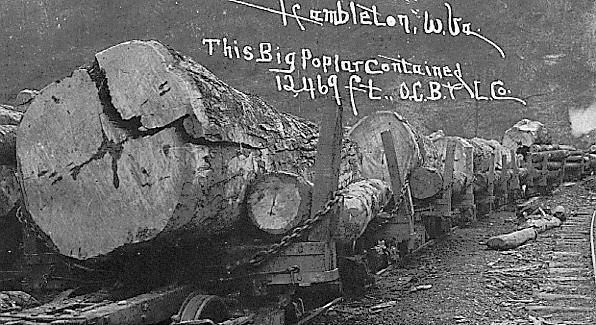
George Washington, during his years working as a land surveyor, recorded a sycamore of gargantuan proportions – 14 feet 4 inches in diameter! (https://sci-hub.tw/10.2307/1931731)
“at the end of the Bottom from the Kanhawa, just as we came to the Hills, we met with a Sycamore at. 60 yards from the River of a most extraordinary size, it measuring (3 feet from the Gd.) 45 feet round, lacking two Inches, and not 50 yards from it was another 31.4 round (3 feet from the Gd. Also).”
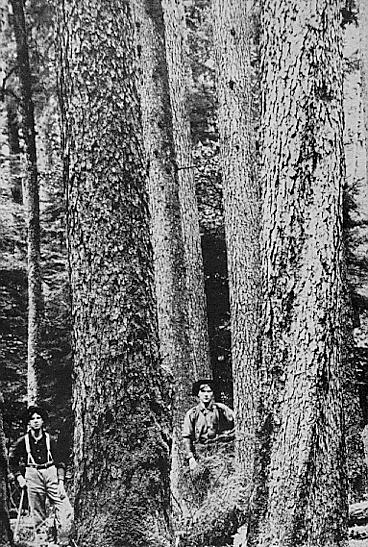
My friend Eric wrote me an email following the original publishing of this blog entry, where he showed me a couple further historical mentions of mammoth eastern trees.
The first reference comes from George Perkins Marsh’s “Man and Nature,” written in 1867. On page 275 he writes:
[Dr. Williams] adds a note saying that a white pine was cut in Dunstable, New Hampshire, in the year 1736, the diameter of which was seven feet and eight inches. Dr. Dwight says that a fallen pine in Connecticut was found to measure two hundred and forty-seven feet in height, and adds: “A few years since, such trees were in great numbers along the northern parts of Connecticut River.” In another letter, he speaks of the white pine as “frequently six feet in diameter, and two hundred and fifty feet in height,” and states that a pine had been cut in Lancaster, New Hampshire, which measured two hundred and sixty-four feet. Emerson wrote in 1846: “Fifty years ago, several trees growing on rather dry land in Blandford, Massachusetts, measured, after they were felled, two hundred and twenty-three feet. All these trees are surpassed by a pine felled at Hanover, New Hampshire, about a hundred years ago, and described as measuring two hundred and seventy-four feet.”
A second reference to the 270-foot-tall Hanover, New Hampshire white pine is found in William Henry Tucker’s 1889 “History of Hartford, Vermont.” He writes of a white pine “found in Hanover 270 feet long.”
A white pine cut around 1850 in Charlemont, Massachusetts, was recorded as being 300 feet tall!
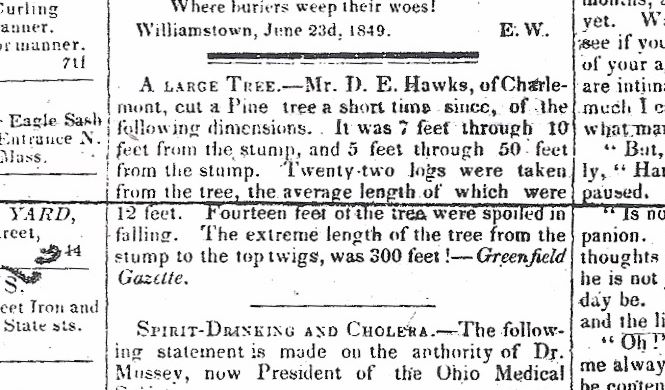
(For more discussion of eastern white pine historic heights, visit the Eastern Native Tree Society discussion.)
One of the tallest eastern white pines in recent history is the Boogerman Pine located in the Great Smoky Mountains. In 1995 it was 207 feet tall, but the top of the tree broke off and today it is just shy of 190 feet.
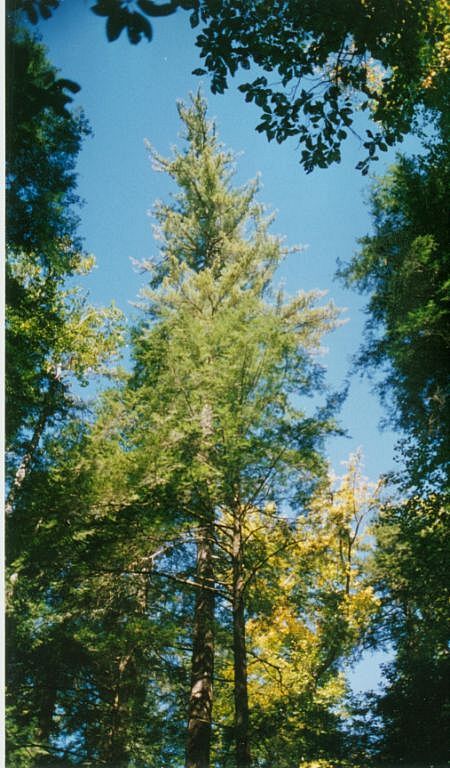
Eastern hemlock — while as a species not quite as tall as the eastern white pine — they can achieve similarly impressive heights. Today, probably the tallest eastern hemlock standing is the Usis Hemlock, at 173 feet tall. (“The Last of the Giants,” American Forests)
Colby Rucker documents some amazing stats in a Bulletin of the Eastern Native Tree Society:
- A white oak with a girth of 21 feet 6 inches was recorded in 1921 in Stony Brook, Long Island, NY.
- A fallen eastern white pine in Meridith, New York was claimed to be 247 feet in length.
- An enormous “black walnut, said to be the ‘the biggest tree east of the Rocky Mountains,’ stood on the banks of Walnut Creek, at the town of Silver Creek, New York. By one account it was 27 feet in circumference, 9 feet in diameter, and 70 feet to the first branch. By another, it was 31 feet in circumference, and over 10 feet thick. It was blown down in 1822. A local grocer had a thirteen-foot section hollowed and fitted with a roof and floor for an addition to his store. A businessman bought the section in 1825, and exhibited it in Buffalo. It changed hands, was shown in New York City, and loaned to a museum in London, England, where it was lost in a fire. The original site, at Ward Avenue and Route 20, is marked by a millstone placed by the DAR in 1928.”
- An American chestnut, girth 26 feet (1921, Esopus, NY – tree died before 1927).
- A huge chestnut “cut in 1895 by a tenant on the farm of D. H. Zile was eleven feet in diameter. The trunk and larger limbs were dynamited, and the tree yielded fifteen cords of firewood. It was said to be ‘the biggest tree in the county, if not the state.’” Located in Taylorsville, Maryland.
- A chestnut near Waynesville, Maryland was said to have a trunk diameter of seventeen feet, considered the greatest known diameter of any eastern hardwood.
- A chestnut stump in the Greenbrier section of the Great Smokies was “13 feet the long way across.”
- American chestnut – girth 33’6”, height 75 feet. Great Smoky Mountains.
- The Boogerman Pine, an eastern white pine which was 207 feet tall before a hurricane broke the top off in 1995. Now it is 185.5 feet tall, and still considered the tallest tree in the eastern United States. Great Smoky Mountains.
- Rich Mountain Pine, an eastern white pine felled to salvage the timber after the top was blown out. Diameter, 6’ up the downhill side was 6 foot 2 inches. The circumference was 19’2”, length to broken top, 168 feet.
- An American chestnut, circumference 28.5 feet at four feet above grade. Great Smoky Mountains, 1933.
- Long-leaf pine in Hattiesburg, Mississippi, “The Tree That Won a Locomotive.” Cut in 1902 or 1903. The butt log of this tree was exhibited at the 1904 Louisiana Purchase Exposition in St. Louis and was 12’ long, and 9’ in diameter at the larger end. It won a competition, receiving a full-sized logging locomotive as the prize.
- A chestnut oak called the Washington Oak. This ancient tree is said to have been seven feet in diameter. George Washington is said to have mounted his horse here in 1783 en route to his army at Fishkill, New York. Was still alive in 1947, but dead by 1974.
Giants Caught on Camera

American Chestnut 
American Chestnut 
American Chestnut 
Chestnut nuts & leaves 
European chestnut grove conveys the sense for what American Chestnut may once have been 
Communal gathering of chestnuts in Fairmount Park, Philadelphia, drawn by artist 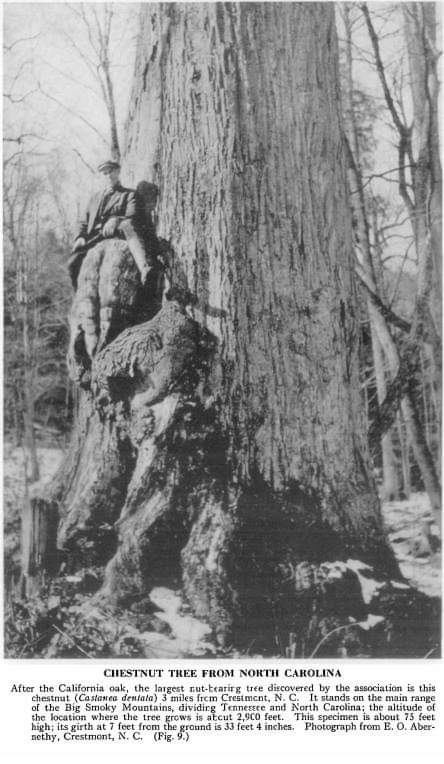
An old American Chestnut in North Carolina




Old-growth white pine, Tioga Tract, Pennsylvania. Comparing to the height of the man at base, this tree was upwards of 180 feet tall! 
Old-growth Sassafras 
“Andalusia” white oak 
Black oak 
White oak 
White oak 
Black oak 
Yellow oak 
Devon Signal oak 
Haddon Heights oak 
Hendrickson Oak, or “Mantua White Oak” 
Stenton tulip poplar 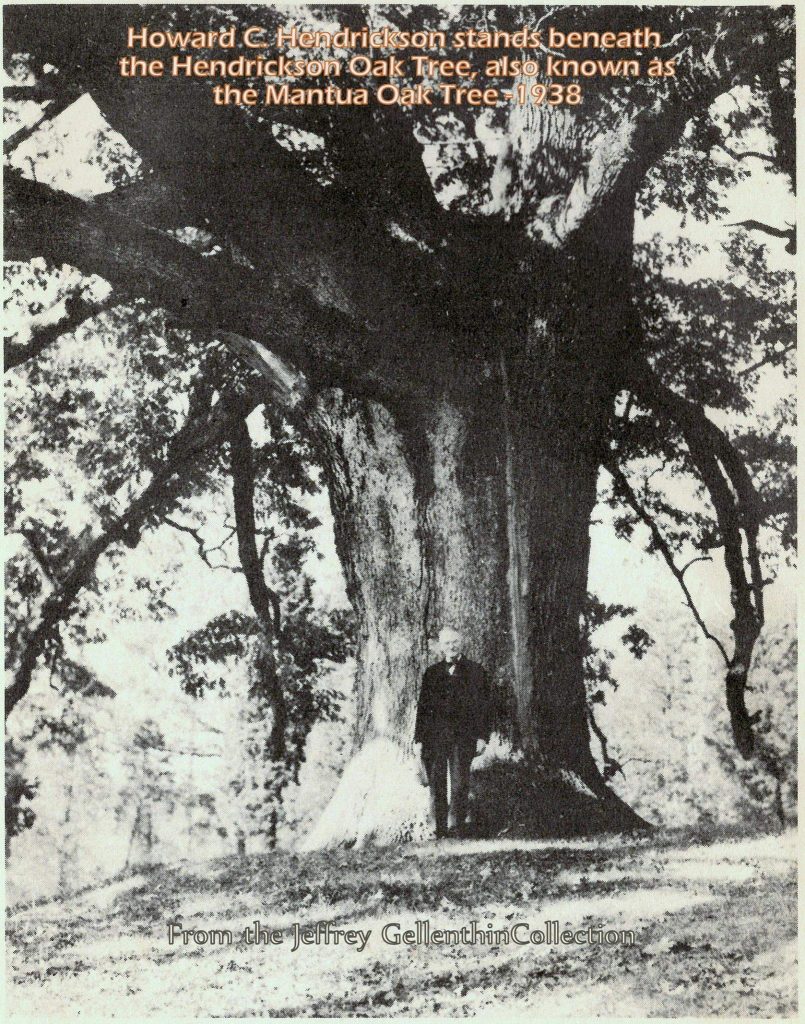
Second view of the Hendrickson, or “Mantua White Oak” 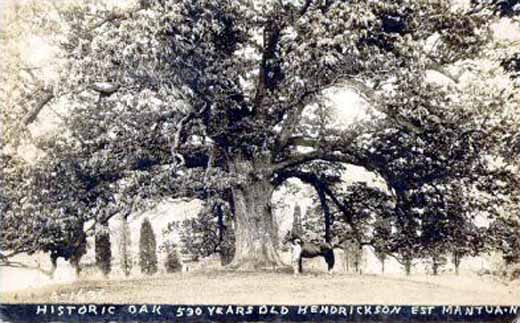
Another look at the Mantua White Oak… 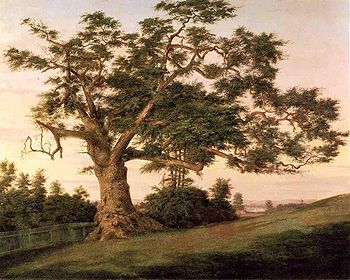
Painting of the “Charter Oak,” which lived in Hartford, Connecticut and fell in a wind storm in 1856.
(Many of the black and white pictures above come from a wonderful, but obscure little book “Penn’s Trees: 1682-1932” by Edward Wildman.)
Searching for the Big Trees Today
Last year, while trekking off trail, along an isolated ridge in the Big Ivy Wilderness in western North Carolina, I came across the splintered trunk of an enormous oak which had died and blown down some years ago. I do not have pictures, but I remember my amazement at the gargantuan proportions of the trunk, which must have been 8 or 9 feet across in diameter. I’d never seen anything like it before, at least so far as oaks go. Big Ivy still has some uncut areas, so there may be more giants out there.
A popular place to see more old-growth trees is the Joyce Kilmer Memorial Forest in Nantahala National Forest. Here one will find tulip poplars just shy of 200 feet tall, with trunk diameters of six and seven feet.
Another place to see big old growth trees is the Sipsey Wilderness of Alabama’s Bankhead National Forest. Bankhead has one of the most diverse forests I’ve ever experienced.

Open-grown white oak in farmer’s field. My wingspan is over 6′, so this oak is possibly 7′ or more in diameter! Although open-grown trees grow fast, this one may still be over 250 years due to its sheer size.


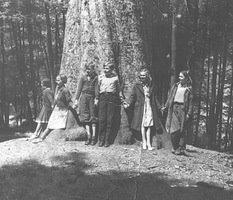
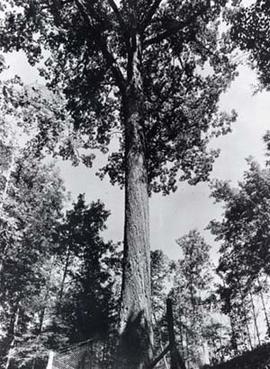


It’s enough to make a person weep for what was lost.